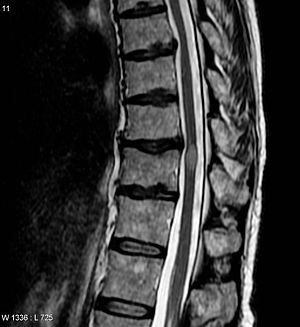Myelitis transversa
| Transverse myelitis | |
|---|---|
 |
|
| An MRI scan showing a transverse myelitis lesion (the lesion is the lighter, oval shape at center-right), this MRI scan was taken 3 months after patient recovered | |
| Specialty | Neurology |
| Causes | Uncertain |
| Diagnostic method | Neurological exam |
| Treatment | Corticosteroids |
| Classification |
· ·
|
|---|
Transverse myelitis (TM) is a rare neurological condition in which the spinal cord is inflamed. Transverse implies that the inflammation extends across the entire width of the spinal cord. Partial transverse myelitis and partial myelitis are terms used to define inflammation of the spinal cord that affects part of the width of the spinal cord. TM is characterized by weakness and numbness of the limbs, deficits in sensation and motor skills, dysfunctional urethral and anal sphincter activities, and dysfunction of the autonomic nervous system that can lead to episodes of high blood pressure. Signs and symptoms are variable and reflect the level of the affected spinal cord.
The underlying cause of transverse myelitis is unknown. The spinal cord inflammation seen in TM has been associated with various infections, immune system disorders, or damage to nerve fibers, by loss of myelin sheaths. Decreased electrical conductivity in the nervous system can result.
Symptoms include weakness and numbness of the limbs, deficits in sensation and motor skills, dysfunctional urethral and anal sphincter activities, and dysfunction of the autonomic nervous system that can lead to episodes of high blood pressure. Symptoms typically develop over the course of hours or days and may progress after weeks. Sensory symptoms of transverse myelitis may include a sensation of pins and needles traveling up from the feet. The degree and type of sensory loss will depend upon the extent of the involvement of the various sensory tracts, but there is often a "sensory level" at the spinal ganglion of the segmental spinal nerve, below which sensation to pain or light touch is impaired. Motor weakness occurs due to involvement of the pyramidal tracts and mainly affects the muscles that flex the legs and extend the arms.
...
Wikipedia
